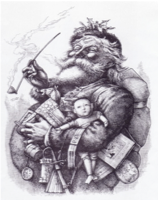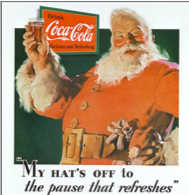
Here’s a picture of the Santa we know; round, bearded, jolly, red-suited, present-giving, chimney-climbing and randomly associated with the birth of Jesus.
Do you see what I mean? Santa is basically a vehicle for the presents, but get rid of the presents, we can legitimately ask, “What has Santa to do with the birth of the savior at Bethlehem?” He’s about as relevant as a bunny at Easter.
How did we get this Santa? You might not know, but there is a real historical person behind this mythical creature we call Santa Clause. Let’s take a look at how we got the myth before we look at the real Santa, and see his relevance to Jesus and the audacious claim that at Christmas we celebrate God becoming a human being.
Our Santa is largely an American invention.
It all began in 1809 when one Washington Irving wrote in a work of fiction called, ‘A Knickerbocker History of New York’, he referred to a character called St Nicholas. St Nicholas was an elfish character who smoked a clay pipe and came down chimneys to bring gifts.
Around 1822, Clement Clarke Moore wrote a poem called, “An Account of a Visit from Saint Nicolas,” with the opening line … ’Twas the night before Christmas’.
“’Twas the night before Christmas, when all thro’ the house,
Not a creature was stirring, not even a mouse;
The stockings were hung by the chimney with care,
In hopes that St. Nicholas soon would be there;
The poem continues with the naming of the reindeer, as well as St Nick smoking the pipe and accessing houses by the chimney and of course bringing presents.
There’s the description. Now, all we needed were the pictures to transform Saint Nicholas to Santa Claus…
And that’s the Santa we have today; the commercial myth, which at best has only a vague relationship with the reality of Christmas through gifts bought and given. But what about the real man? Who is Saint Nicholas?
Saint Nicholas the man?



Well, let’s just establish the verbal connection –
Santa = Saint Claus = (Ni)cholas

Born in the third century in Patara, in what is today southern Turkey. His wealthy Christian parents died when he was young. He gave away all he had to the poor, the sick and suffering. He became the bishop of Myra. He was persecuted under the emperor Diocletian and died on December 6, AD 343.
Saint Nicholas was generous to children – and the legends associated with him has him giving them gifts.
Which is all well and good, but how did this holy guy get associated with Christmas? His historical connection with Christmas at first seems as tenuous as ‘Jingle all the way’, but I think there is a better and more important association than just giving gifts to kiddies in December.
Saint Nicholas went to the Council of Nicea.
This was a Council that was all about Christmas, all about the baby Jesus and all about who he really was and is.
There was a popular preacher in Alexandria in Egypt, called Arius, who said that Jesus wasn’t really God. This caused such an uproar that Emperor Constantine called all the bishops together to form the Council of Nicea. What was Nicholas’ role in the council?
When he heard Arius denying the divinity of Jesus this is what he did as depicted in the picture below.

That’s Nicholas to the right, with the tan ‘plate’ or halo behind his head, and Arius is on the left. Saint Nicholas is striking Arius on the head, I think he was trying to knock a bit of sense into him. Arius was definitely on Saint Nicholas’ naughty list!
What is the real message of Christmas about? The real Santa Claus, Saint Nicholas, understood it and fought for it. Christmas is about a staggering claim – that what we see in the baby, the boy, and the man called Jesus; what we see in the character and the message of Jesus; and what we see in his death and resurrection, is nothing less than the great glorious God of the universe in the flesh.
Here is a great quote from Michael Reeves who explains this so well…
Here, then, is the revolution: for all our dreams, our dark and frightened imaginings of God … there is no God in heaven who is unlike Jesus. For he is God. “Anyone who has seen me has seen the Father,” he says, for “I and the Father are one” (John 14:9; 10:30). God cannot be otherwise. This was the subject of what was perhaps the greatest battle the church fought in the centuries after the New Testament: to uphold the belief that Jesus truly is God, none other than the LORD God of Israel himself. He is, as was enshrined in the stirring words of the Nicene Creed, “God from God, light from light, true God from true God, begotten not made, one being with the Father.” And no wonder they loved this truth, for through it the sunshine bursts in upon our thoughts of who God is, and what all reality is about: there is no God in heaven who is unlike Jesus… Let us then be rid of that horrid, sly idea that behind Jesus, the friend of sinners, there is some sinister being, one thinner in compassion and grace. There cannot be! Jesus is the Word. He is one with his Father. He is the radiance, the glow, the glory of who his Father is. If God is like Jesus, then, though I am sinful like the dying thief, I can dare cry, “Remember me” (see Lk 23:42). I know how he will respond. Though I an so spiritually lame and leprous, I can call out to him. For I know just what he is like toward the weak and sick.
p 14-15 Rejoicing in Christ Michael Reeves
This is the staggering, unlooked for, ‘joy to the world truth’ of Christmas; if I keep looking at what Jesus does and what he says in the gospels – I see God. And the God I see is humble, gracious, forgiving and loving. I need, we all need, a God just like that, and in Jesus I not only see him face to face, I see him close up and real and near.
For me that’s the joy of Christmas and that what the real Santa Claus fought for – the truth of who the baby born in a shed really is – God in the flesh – the true gift that keeps on giving.
Enjoy Santa’s presents. But when you’ve opened them all, and you’ve had your dinner, the real gift is still to be delighted in and tasted. The gift of God himself in Jesus.
Happy Christmas. Merry Christmas. Joy to your world from the team at Church2Church.
